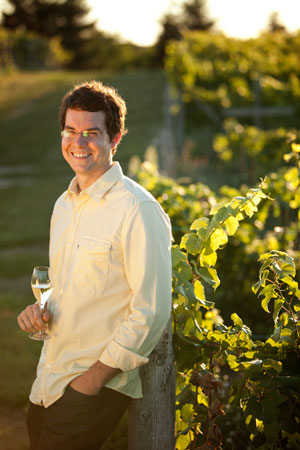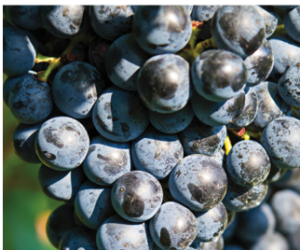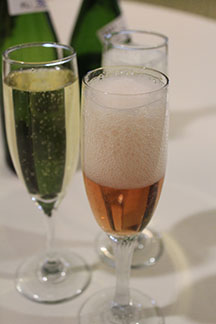Sparkling wines can be one of the most versatile food-wine pairings available and are enjoyed on so many occasions — but producing them at home can be challenging. We brought in two experts in the field of producing sparkling wines to discuss.
Andrew Rockwell is the Head Winemaker at Sparkling Pointe in Southold, New York
Here at Sparkling Pointe, we utilize the méthode champenoise to produce our sparkling wines. In a nutshell, a bottle of méthode champenoise/méthode traditionelle is a sparkling wine whose carbonation was created by a secondary fermentation in that specific bottle typically carried out by the addition of sugar and yeast to a still base wine at the time of bottling then aged on the lees for a period of time before being riddled and disgorged to obtain a clear wine free of sediment.
Carbonation plays a big role in the acid balance and aromatic intensity of wines. Dissolved CO2 gives an impression of acidity. A small portion of dissolved CO2 dissociates into carbonic acid in solution. So a wine will taste more lively, fresh, and acidic with the addition of carbonation. The effervescence will magnify the intensity of the wine aromas as more, particularly aromatic compounds. Also, if we’re talking about méthode champenoise, the aging on the lees is a critical factor. The breakdown of the dead yeast cells (autolysis) gives the distinct biscuity, nutty, yeasty, bread-like flavors associated with this style of wine and contributed positively to mouthfeel, mousse structure, and bubble size.
Pinot Noir and Chardonnay are the classic grapes for a reason. They bring the aroma, elegance, acidity, and balance that make great méthode champenoise wines what they are. However, any wine can of course become sparkling. Generally, grapes with lower sugars, low pHs, and high acids make the best sparklings. Its important the starting base wine has less then 11% alcohol to help ensure a successful secondary fermentation so anything >20 Brix to start could be problematic.
While it is certainly possible to make this style at home it is not for the faint of heart. Be prepared to experience leaking bottles, exploding bottles, broken glass, gushing, foaming, significant volume losses and taking up a lot of real estate in your production space for the riddling process. Sounds fun right? It is a multiple step process with a steep learning curve that rewards precision and patience. I would generally not recommend this method for the home winemaker due to the many steps required and the difficulty of riddling and disgorging by hand. Unfortunately, the other styles of sparkling wine aren’t much better for the home winemaker and each have their own unique challenges. So, if someone wants to make a full pressure (6 bar) sparkling wine at home, the methode champenoise, while quite challenging, may still be the best option.
Andrew Rockwell’s Méthode Champenoise Tips
So many steps, so many possible recommendations, where to start? Forced carbonation will always be easier but the results are never as good. You will have more success if you plan for making your sparkling wine from the beginning of your process. Don’t try to just use some random wine that has been sitting around. Think about how every step could effect your eventual secondary fermentation. Be cautious about sulfite additions during the winemaking process as having more then 10 ppm Free SO2 in your base wine at bottling may prevent secondary fermentation. Aim on the side of using less sulfites and bottling as early as possible post-primary ferment. It helps to have a clean and clear base wine. If you are able to filter or fine your wine prior to the final addition of sugar and yeast you will have more of a chance of success. It’s better to store the wine horizontally and then when riddling slowly move from a horizontal position to a vertical position to help the yeast settle out but maybe logistically challenging at home. When you plan to riddle if you don’t want to buy or construct a riddling rack just shake the bottles by hand to suspend the sediment, turn them upside down, put them in a case box and wait 2–4 weeks to see if lees has settled out. Look with a flashlight. If there is still sediment stuck to the sides of the glass, agitate the bottles gently while maintaining they’re vertical upside down position, wait 1–2 weeks, check again and repeat if necessary.
Riddling is achieved by a combination of agitation, gravity, and time. Chill the bottles and anything you plan to add to them before attempting to disgorge will help reduce foaming and gushing. Disgorging is possible without freezing the neck of the bottle but challenging. It’s the way they used to do it in Champagne long ago. If you get a good light on your bottle, follow the air bubble as you slowly tip it upright, and time your opening at just the moment the bubble reaches the sediment and it works! Easier said then done I’m afraid but most people don’t have -13 °F (-25 °C) glycol baths at home to help them freeze the necks of their bottles like we do at the winery. They do make a special bottle opener with a handle and curved neck just for hand disgorging. It is a tool worth investing in if one plans to home disgorge. Please wear goggles during the process and always aim the cap into bucket or other container to collect the yeast plug and help reduce making a mess everywhere. If you do plan to recap or cork just top the bottles with an extra bottle or if you want to introduce some sweetness make what is called a liqueur en dosage. Other flavorings could also be added at this stage as well but avoid any particulates as it could cause unwanted gushing to occur. A standard classic liqueur is simply made by adding 1 kg of sugar to 1 L of filtered wine or water and mixing until dissolved. Adding 2–4 g/L of Potassium metabisulftie to your liqueur can help to freshen up and preserve the wine for further aging. 10 mL of this liqueur per 750 mL bottle is a good starting point (makes a brut style of ~8 g/L residual sugar) but more or less could be added dependent on the final desired sweetness balance, just note that some wine may need to be removed from the bottle to make room for the addition of the liqueur.
We aim for the classic champenoise style, 5-6 bars at 68 °F (20 °C), which is roughly 12 g/L CO2 or for those familiar with volumes of CO2 from brewing beer, that would be about 6 volumes of CO2. That’s 2–3 times the pressure one would find in a typical beer, which usually sit around 2.5 volumes of CO2.
Eye protection — or even better a face shield — gloves, long sleeves and pants are recommended when handling. Bottles have a tendency to rupture in an explosive fashion and with a force of roughly 120 psi (830 kPa) inside the bottle there is a real danger from flying glass shards. Well made bottles and crown caps that are rated to hold 2–3 times the pressure you plan to reach inside the bottle is a good idea. If you plan to disgorge it will be a lot easier if you bottle with a crown cap and bidule. They make crown caps with a bidule already set in them, which would help save a step. If you intend to cork the bottles at any stage wire hoods are needed to keep the corks from popping. To keep things easier I would recommend for the home winemaker to just reapplying crown caps again post-disgorgement. Watch out for the fact that there is a separate European (29 mm) and American standard (26 mm) crown cap closure. Make sure your bottle, crowns, and capper are all for the same size closure.
Michael Laing is the Owner/Winemaker at MAWBY on Leelanau Peninsula, Michigan
When it comes to putting bubbles into the still wine, here at MAWBY we will either re-ferment in pressure tank (Charmat method) or in the bottle (traditional method). In the Charmat method, we will add a fresh dose of yeast with the sugar in a pressure tank. The refermentation occurs in the vessel and we bottle from there. Charmat method provides a more “grape-forward” sparkling wine. I would recommend, for the home winemaker, to bottle ferment wines though. The bottle ferment provides the more traditional autolysis character revered in the Champagnes.
We shoot for 4.8 volumes of dissolved CO2 in our tank-fermented wines and 6 volumes in our bottle-fermented wines. This is achieved by adding 19 g/L of sugar when we re-ferment in pressure tank and 24 g/L sugar for bottle-fermented wines.
Use the right bottle — make sure it can handle the pressure. If you re-ferment by adding sugar, always double check your math to make sure your calculations are correct. Of special note, if your base wine is not dry, factor that residual sugar in as well. These details can make a big difference.
You need a clear path for your sparkling wine. For a classic Champagne-style I would suggest Pinot Noir and Chardonnay, or you could look at adding Pinot Blanc or Pinot Gris. For fruit-forward bubblies I would use other, more aromatic varieties such as Riesling, Vignoles, Traminette, Grüner-Veltliner, Gewürztraminer, etc.
Finally, I would say to first time sparkling winemakers: Try to carbonate a wine to get an idea of what bubbles do on the palate compared with still wine. Play around with different varieties. You could try refermenting in a small soda bottle with some sugar and wine. Just don’t go too high with the carbonation levels. If you really get into sparkling wines, you could think about getting a kegging system of your own (like a homebrewer).






